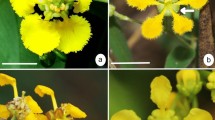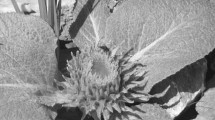Abstract
Controlled pollinations and observations of pollen tube growth, pollen fertility and cytological data were studied in 11 species ofMelastomataceae growing in “cerrado” in SE Brazil. Seven species produced apomictic fruits with viable seeds. Four species were not apomictic, with two self-incompatible (gametophytic SI) and two self-compatible, one showing spontaneous self-pollination. The apomictic species had lower pollen fertility than sexual ones — although in some cases differences were not significant — showing that low pollen fertility may be a useful indicator of apomixis if analysed using careful sampling supplemented by emasculation experiments. The apomictic species also showed meiotic irregularities, probably related to hybridization, polyploidy and the cause of low pollen fertility. Apomixis in this group probably is more associated with taxonomy and phylogeny than habitat or habit, since 85% of the apomictic species reported in the literature belong to the tribeMiconieae and occur in a wide range of vegetation types and have diverse habits. This suggests the existence of very extensive apomictic complexes comparable to those reported in mainly temperate genera ofAsteraceae andRosaceae.
Similar content being viewed by others
References
Almeda, F., 1977: Systematics of the neotropical genusCentradenia (Melastomataceae). — J. Arnold Arbor.85: 73–108.
—, 1978: Systematics of the genusMonochaetum (Melastomataceae) in Mexico and Central America. — Univ. Califonia Publ. Bot.75: 1–134.
—, 1992: Chromosome numbers and their systematic significance in some MexicanMelastomataceae. — Syst. Bot.17: 583–593.
Baker, H. G., Bawa, K. S., Frankie, G. W., Opler, P. A., 1983: Reproductive biology of plants in tropical forests. — InGolley, F. B., (Ed.): Tropical rain forest ecosystems — structure and function. — Amsterdam: Elsevier.
Baumgratz, J. F. A., Silva, N. M. F., 1988: Ecologia da polinização e biologia da reprodução deMiconia stenostachya DC. (Melastomataceae). — Rodriguesia64/66: 11–23.
Bayer, R. J., 1990: Patterns of clonal diversity in theAntennaria rosea (Asteraceae) polyploid agamic complex. — Amer. J. Bot.77: 1313–1319.
Berry, P. E., Tobe, H., Gomez, J. A., 1991: Agamospermy and loss of distyly inErythroxylum undulatum from Northern Venezuela. — Amer. J. Bot.78: 595–600.
Bierzychudek, P., 1987: Patterns in plant parthenogenesis. — InStearns, S. C., (Ed.): The evolution of sex and its consequences. — Basel: Birkhäuser.
Borges, H. B. N., 1991: Biologia reprodutiva de quatro espécies deMelastomataceae. — M.Sc. Thesis, Universidade Estadual de Campinas, Brazil.
Burnham, C. R., 1962: Discussions in cytogenetics. — Minneapolis: Burgess.
Dent-Acosta, S. R., Breckon, G. J., 1991: Reproductive biology of six species ofMelastomataceae in Western Porto Rico. — In: First InternationalMelastomataceae Symposium. — Washington: Smithsonian Institution.
Ethridge, A. L., Herr, J. M., 1968: The development of the ovule and megagametophyte inRhexia mariana. — Canad. J. Bot.46: 133–139.
Gentry, A. H., 1974: Flowering phenology and diversity in tropicalBignoniaceae. — Biotropica6: 64–68.
Giannotti, E., 1988: Composição florística e estrutura fitossociológica da vegetação de cerrado e mata ciliar da Estação Experimental de Itirapina (SP). — M.Sc. Thesis, Universidade Estadual de Campinas, Brazil.
Gibbs, P., 1990: Self-incompatibility in flowering plants: a neotropical perspective. — Revista Brasil. Bot.13: 125–136.
Gross, C. L., 1993: The breeding system and pollinators ofMelastoma affine (Melastomataceae), a pioneer shrub in Tropical Australia. — Biotropica25: 468–473.
Guimarães, P. J. F., Stranghetti, V., Ranga, N. T., 1993: Polinização e reprodução deRhynchanthera dichotoma (Lam.) DC. (Melastomataceae). — In: Anais do XX Colóquio de Incentivo à Pesquisa. — São José R. Preto: UNESP.
Gustaffsson, A., 1946: Apomixis in higher plants. Part I. The mechanism of apomixis. — Acta Univ. Lund.42: 1–66.
—, 1947a: Apomixis in higher plants. Part II. Causal aspects. — Acta Univ. Lund.43: 72–178.
—, 1947b: Apomixis in higher plants. Part III. Biotype and species formation. — Acta Univ. Lund.43: 183–349.
Ha, C. O., Sands, V. E., Soepadmo, E., Jong, K., 1988: Reproductive patterns of selected understorey trees in the Malaysian rain forest: the apomictic species. — Bot. J. Linn. Soc.97: 317–331.
Kaur, A., Ha, C. O., Jong, K., Sands, V. E., Chan, H. T., Soepadmo, E., Ashton, P. S., 1978: Apomixis may be widespread among trees of the climax rain forest. — Nature271: 404–442.
Magnusson, W. E., Sanaiotti, T. M., 1987: Dispersal ofMiconia seeds by the ratBolomys lasiurus. — J. Trop. Ecol.3: 277–278.
Martin, F. N., 1959: Staining and observing pollen tubes in the style by means of fluorescence. — Stain Technol.34: 125–128.
Melo, G. F. A., 1995: Biologia floral e sistema reprodutivo de cinco espécies deMelastomataceae na mata de Dois Irmãos, Recife, PE. — M.Sc. Thesis, Universidade Federal de Pernambuco, Brazil.
Mogie, M., 1992: The evolution of asexual reproduction in plants. — London: Chapman & Hall.
Mori, S. A., Pipoly, J. S., 1984: Observations on the Big Bang flowering ofMiconia minutiflora. — Brittonia36: 337–341.
Nogler, G. A., 1984: Gametophytic apomixis. — InJohri, B. M., (Ed.): Embryology of angiosperms. — Berlin, Heidelberg, New York: Springer.
Nygren, A., 1954: Apomixis in angiosperms. Part II. — Bot. Rev.20: 577–649.
Oliveira, P. E. A. M., 1991: The pollination and reproductive biology of a cerrado woody community in Brazil. — Ph.D. Thesis, University of St. Andrews, UK.
—, 1992: Contrasting breeding systems in twoEriotheca (Bombacaceae) species of the Brazilian cerrados. — Pl. Syst. Evol.179: 207–219.
Piedade, L. H., Ranga, N. T., 1993: Ecologia da polinização deGalipea jasminiflora Engler (Rutaceae). — Revista Brasil. Bot.16: 151–158.
Pinheiro, M. C. B., 1995: Biologia da reprodução de cinco espécies daMelastomataceae da Restinga de Maricá — RJ. — Doctoral Thesis, Universidade Estadual de Campinas, Brazil.
Prance, G. T., 1987: Biogeography of neotropical plants. — InWhitmore, T. C., Prance, G. T., (Eds): Biogeography and Quaternary history in Tropical America. — Oxford: Clarendon Press.
Ramirez, N., Brito, Y., 1990: Reproductive biology of a tropical palm swamp community in the Venezuelan llanos. — Amer. J. Bot.77: 1260–1271.
Renner, S. S., 1987: Reproductive biology ofBellucia (Melastomataceae). — Acta Amazonica16–17: 197–208.
—, 1987:Sandemania hoehnei (Melastomataceae:Tibouchineae): taxonomy, distribution, and biology. — Brittonia39: 441–446.
—, 1989: A survey of reproductive biology in neotropicalMelastomataceae andMemecylaceae. — Ann. Missouri Bot. Gard.76: 496–518.
—, 1993: Phylogeny and classification of theMelastomataceae andMemecylaceae. — Nordic J. Bot.13: 519–540.
Richards, A. J., 1986: Plant breeding systems. — London: Allen & Unwin.
Saraiva, L. C., 1994: Biologia da reprodução de arbustos e árvores do cerrado em Corumbataí, Estado de S. Paulo. — Doctoral Thesis, Universidade Estadual Paulista, Brazil.
Sobrevila, C., Arroyo, M. T. K., 1982: Breeding systems in a montane tropical cloud forest in Venezuela. — Pl. Syst. Evol.140: 19–37.
Sokal, R. R., Rohlf, F. J., 1981: Biometry. — New York: Freeman.
Solt, M. L., Wurdack, J. J., 1980: Chromosome number inMelastomataceae. — Phytologia47: 199–220.
Stebbins, G. L., 1971: Chromosomal evolution in higher plants. — London: Arnold.
Author information
Authors and Affiliations
Rights and permissions
About this article
Cite this article
Goldenberg, R., Shepherd, G.J. Studies on the reproductive biology ofMelastomataceae in “cerrado” vegetation. Pl Syst Evol 211, 13–29 (1998). https://doi.org/10.1007/BF00984909
Received:
Revised:
Accepted:
Issue Date:
DOI: https://doi.org/10.1007/BF00984909




